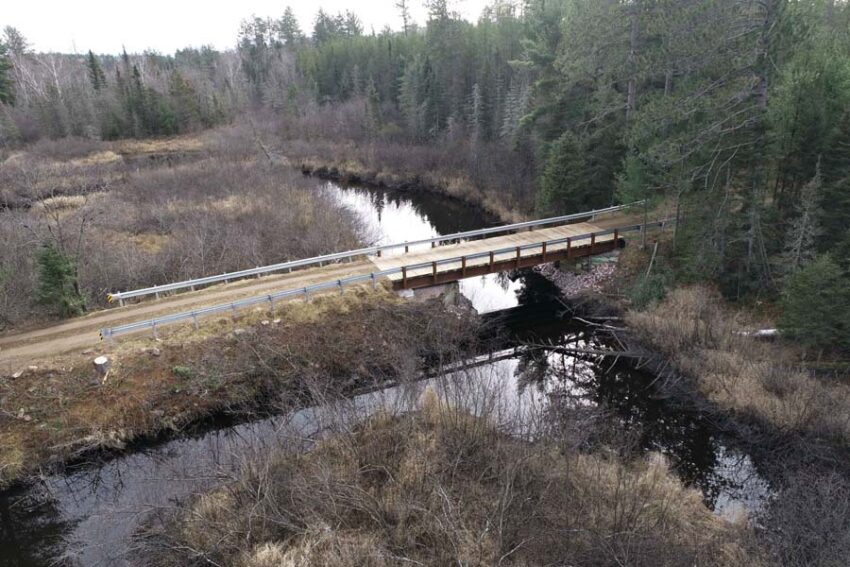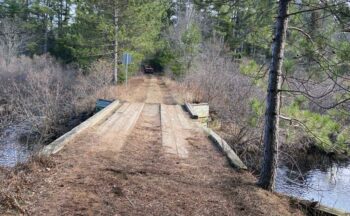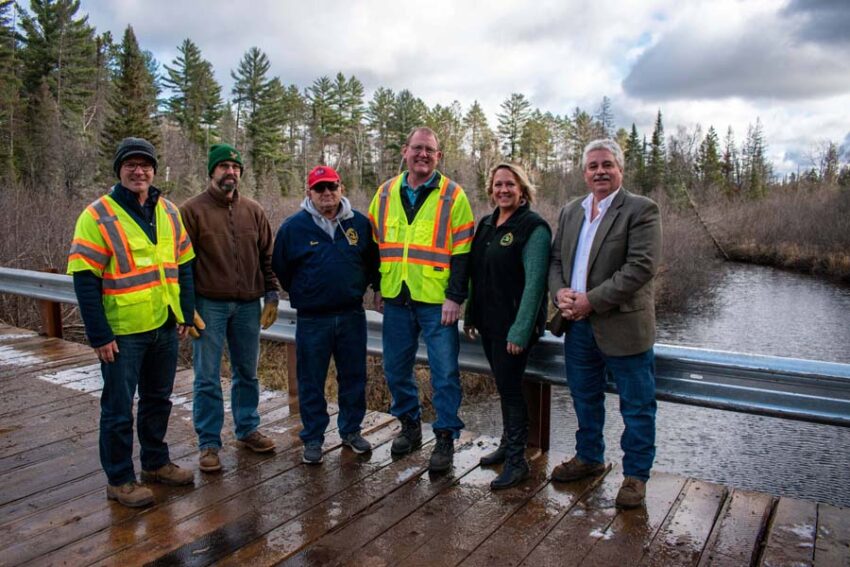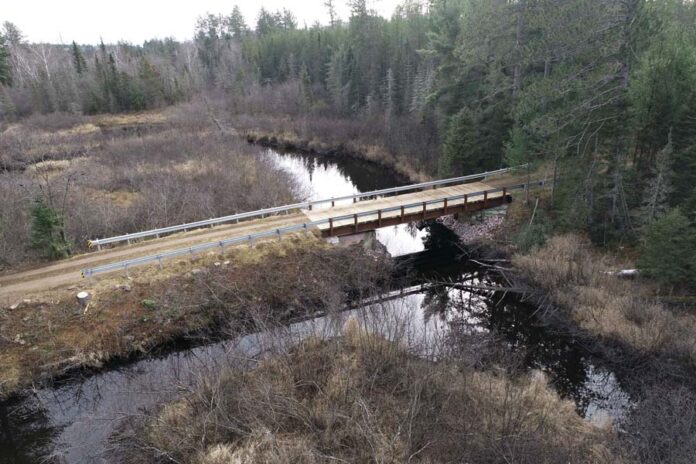
MARQUETTE CO., MI – If you follow the forest route in Marquette County to where the Black River slowly rolls, the creek travels through the swamps and tag alders, as dark as molasses.
The river is only about 30 feet wide here, but in October 2019 it might as well have been a thousand miles.
Back then, a handful of landowners who own property on the far side of the river were told the battered, wood-decked bridge they had used for decades had been condemned by the Michigan Department of Transportation.
Without the bridge there would be no way for these people to reach their land on the other side of the river, where they had built camps, hunted deer and otherwise enjoyed the outdoors in this remote area south of Ishpeming.
“The bridge was evaluated by MDOT several years ago and a 12-ton weight limit was placed on it,” said Tom Seablom, western Upper Peninsula district supervisor for the Michigan Department of Natural Resources Forest Resources Division.

The DNR had explored the cost of replacing the bridge with the Michigan Department of Technology, Management and Budget and an engineering firm. The price tag was estimated at $400,000 to build a span able to withstand a regular highway load.
“We put the project on hold to better determine if it is a worthwhile investment of public dollars for what it does for access to state forest land,” Seablom said then.
The bridge remained on a list of eventual DNR replacement projects.
Then, about a month before the opening day of the firearm deer hunting season, MDOT bridge inspectors visited the site and found that the bridge, which had been built from an old railroad car, was in a “state of imminent failure.”
Inspectors had found deficiencies in the supporting structure and decking of the 33-foot-long bridge, suggesting a replacement was likely the most effective solution, rather than attempting repairs.
The DNR was ordered to gate the nearly 40-year-old bridge closed immediately to all vehicle traffic. The DNR notified the affected landowners and issued a news release to the public.
At that point, the DNR had no further obligation given that the crossing was not necessary to access state forest land for forest management purposes.
No record was located of an easement for use of the bridge or forest route to benefit any of the adjacent landowners. The landowner with access from the other side of the river did not want to pursue offering an easement for public use.
Landowners contacted several DNR staffers and various public officials, including county commissioners, hoping for a better resolution to the issue.
“Upper Peninsula DNR staff asked for the help of divisional chiefs, a deputy director, staff attorney and the DNR director to craft a creative approach to help the landowners, especially to let them be able to hunt,” said Stacy Welling-Haughey, DNR U.P. field deputy. “The DNR drafted an agreement that would allow the landowners to have limited access across the failing bridge after they signed a waiver.”
No full-sized vehicles were permitted on the bridge, but access could be gained with off-road vehicles or snowmobiles. The agreement was permitted only until Dec. 31, 2019.
“A meeting was held at the Marquette DNR office and landowners were all provided with a key to the gated bridge for access,” said Welling-Haughey. “It was a temporary and creative solution.”
Early the following year, the DNR and the landowners had considered three primary options to address the situation for the long-term:
- The landowners could sell the property to the DNR.
- The DNR could sell the property to the landowners, including the bridge.
- A land exchange could be considered for the landowner properties.
A few months later, as discussions and exploration of the issue continued, an updated slate of potential options was developed:
- Maintain the status quo: The state-owned bridge, condemned by MDOT, would remain gated with closed signs posted.
- The landowners could pursue purchasing the approximately 1-acre property around the bridge which they could then maintain as a private crossing. A final purchase price would be determined during an application review process.
- Pursue a potential partnership between the Marquette County Road Commission and the DNR.
It was this novel third option that was ultimately selected. The DNR was contacted by the road commission and county board members in spring 2020.
Under the cooperative partnership agreement, the DNR paid the road commission to remove the existing bridge, build and install a new bridge, restore approaches to the bridge, with the span built adhering to MDOT-approved standards.

“The road commission was excited to work with the DNR to design and construct a cost-effective bridge structure to provide access across the Black River for the citizens of Marquette County and the residents of the state of Michigan,” said Jim Iwanicki, engineer-manager of the Marquette County Road Commission.
The cost of the project was $230,000, which represented a 43% savings totaling $170,000 to the state of Michigan. No cost was incurred by the landowners.
The state maintained an interest in repairing the bridge for timber harvests and to provide access to state-managed lands by the general public.
The bridge opened to traffic in October 2021, with the first heavy load being a propane truck delivering fuel to the camps as the landowners again readied themselves for another deer hunting season.
The interesting cooperation that developed between several parties throughout this issue was something some DNR officials had hoped might have been achieved in other circumstances over many years.
“We look forward to continuing our partnership with the DNR to provide low cost-effective bridge crossings for the taxpayers in the state of Michigan in the future,” Iwanicki said.
Maybe it was an idea whose time had come or perhaps necessity proved itself once again to be the mother of invention.
Whatever the case, the unique circumstances that resulted have led the Michigan DNR, county road commissions and local public officials discover a potential new mechanism to bridge other gaps in funding at other locations in the years to come.
This type of effort might become increasingly important in the wake of the coronavirus pandemic, which has complicated construction efforts with rising costs, supply chain snags and skilled labor shortages.
Not long after the bridge over the Black River reopened, the partners in the project met on a cold afternoon to get a first-hand look at the new construction. They walked across the span and posed for a celebratory photograph.
Despite the cloudy and windy day, with snowflakes in the air, the future of the partnership they had developed together appeared bright and sunny.
Check out previous Showcasing the DNR stories in our archive at Michigan.gov/DNRStories. To subscribe to upcoming Showcasing articles, sign up for free email delivery at Michigan.gov/DNR.


